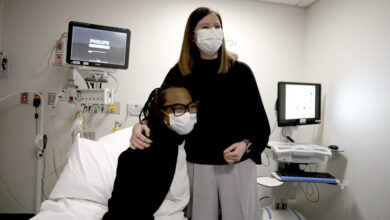First-of-its-kind wearable device gauges health by sensing how skin ‘breathes’
Skin health is an essential aspect of overall well-being, and advancements in technology are constantly improving our ability to monitor and assess it. Northwestern University researchers have recently developed a groundbreaking wearable device that can measure gases emitted from and absorbed by the skin, providing valuable insights into various skin conditions and overall health.
The device, featured in a study published in the journal Nature, comprises sensors that measure changes in temperature, water vapor, carbon dioxide, and volatile organic compounds (VOCs) on the skin. By analyzing these gases, the device can offer insights into skin health, wound monitoring, skin infections, hydration levels, exposure to environmental chemicals, and more.
One of the key features of this wearable technology is its non-contact design, which allows it to hover above the skin without touching it. This feature is particularly useful for gathering information about fragile skin without causing any disturbance to delicate tissues.
The device works by collecting gases in a small chamber above the skin and then measuring changes in gas concentrations over time. By tracking variations in water vapor and gas emissions, healthcare professionals can gain valuable information about the integrity of their patients’ skin barriers.
The compact size of the device, measuring just two centimeters long and one-and-a-half centimeters wide, makes it ideal for continuous monitoring and remote healthcare. The data collected by the device can be sent wirelessly to a smartphone or tablet for real-time monitoring, allowing healthcare workers to make informed decisions quickly and efficiently.
One of the key applications of this technology is in wound care, where continuous monitoring of gas emissions can help detect infections early and guide treatment decisions. By tracking changes in water vapor, CO2, and VOCs, caregivers can identify bacterial growth and delayed healing, leading to more effective wound management and antibiotic administration.
Moreover, the device has the potential to revolutionize the assessment of bug repellents, skin creams, and systemic medications designed to improve skin health. By measuring emissions from the skin, researchers can gain insights into mosquito attraction, skin permeability, and the effectiveness of skincare products.
In the future, the Northwestern research team plans to enhance the device’s capabilities by adding sensors to track pH levels and developing sensors with increased chemical selectivity for early disease detection. This innovative technology opens new possibilities for personalized healthcare that is driven by real-time, non-invasive monitoring of skin health parameters.
Overall, the development of this wearable device represents a significant step forward in skin health monitoring and offers a promising tool for healthcare professionals and individuals to take control of their skin health. With its ability to provide real-time insights and continuous monitoring, this technology has the potential to transform clinical care and improve outcomes for patients with various skin conditions.





